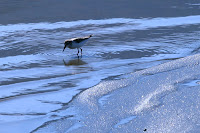We arrived in the dark to Lake Quinault Lodge, unsure of much of what we might find in the daylight of the next morning. Sure, only, that we were still in the land of the very tall trees, their towering dark forms following us down the coast from Kalaloch, inland —a narrow, untraveled road winding between them.
By morning, the expected fog had settled into the valley, leaving us looking out upon nothing but white. The chairs on the sloping lawn beyond the dining room, arranged as if in a theatre, facing the curtain—a lake, unseen, beyond.
Certainly there must be some beauty here--some reason people are drawn to look out.
But what upon?
Breakfast passed.
Sweet Potato Pancakes with hazelnut butter,
Applewood chicken sausage
and Starbucks coffee.
Then a stroll down the hill to the water’s edge, the lake still waiting behind fog.
 canoes and kayaks on the shore on a foggy morning
canoes and kayaks on the shore on a foggy morning
Lake Quinault
 Wilson's Warbler gleaning insects from spider webs on shore
Wilson's Warbler gleaning insects from spider webs on shore
 pretty purple at water's edge
pretty purple at water's edge rowboat in fog
rowboat in fog
In a green Old Town canoe much like ours at home, we paddled out across the glassy surface. Almost like a skater’s blade on an icy pond--effortless. In the quiet stillness of evergreen mountains, a loon's call through the mist from the opposite shore.
The curtain was lifting.

From every side we were surrounded, in dense hemlock, spruce and fir, some a thousand years old, the world's giants. Gravel arms reached out from hidden coves where small streams fed clean, clear water beneath us, before dropping deeply into the glacier-carved basin.
A blue sky, now, transparent above as the water below.

At the far end of the lake we came upon colored sands, of pumpkin, rust and deep red. Indeed, every thing that touched upon the water here, had been tinted in warm, glowing tones.
 Iron (?) deposits on sand and stones near inlet of Quinault River
Iron (?) deposits on sand and stones near inlet of Quinault River rust-colored sand bubbling on banks
rust-colored sand bubbling on banks Western Sandpiper feeding on sandy shore
Western Sandpiper feeding on sandy shore
And to the north, stands of Red Alder, like birch, their white bark bright in the evergreen woods.
A landscape painted in blues, dressed in lively shades of green.

We stopped for our lunch on a clean gravel bank, and pulled the canoe just far enough onto the shore to not lose it.
The faintest breeze, welcome.
The day now, warm, as we peeked out from under shady branches.


Then crossed the 2-mile width, back to the base of Quinault Lodge.
The chairs on the sloping lawn, full of spectators in this theatre of wild, natural beauty.
 looking east toward Colonel Bob Wilderness
looking east toward Colonel Bob WildernessLake Quinault from Hwy 101
 sitting in the lap of the world's largest spruce tree
sitting in the lap of the world's largest spruce tree
Lake Quinault, Washington
all photos click to enlarge
 See more Skywatch here.
See more Skywatch here. 



















































































%20copy%202.jpg)

















